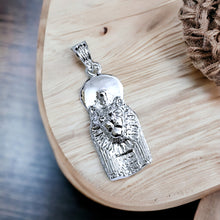
The Silver Goddess Sekhmet Pendant Necklace embodies ancient Egyptian reverence, featuring the fierce lioness-headed goddess Sekhmet, symbolizing power and protection. Inspired by the rich history of Egyptian civilization, this pendant pays homage to one of its most formidable deities, revered for millennia as a guardian and healer.
- History: Inspired by ancient Egyptian mythology, Sekhmet is a lioness-headed goddess associated with war and healing.
- Spiritually: Represents strength, protection, and healing powers.
- Talisman: Believed to ward off evil and bring courage and vitality to the wearer.
- Handmade: Crafted with intricate details by skilled artisans.
- Healing: Thought to promote physical and emotional well-being.
- Material: Made from sterling silver, a metal associated with purity and clarity.
- Symbolism: Depicts Sekhmet's fierce yet nurturing nature, symbolizing both power and compassion.
- How to Wear: Designed to fit any chain up to 5mm, allowing for versatile styling options.
History Side For Those Who Are Interested
Sekhmet, a prominent deity in ancient Egyptian mythology, held sway as the lion-headed goddess of war, healing, and protection. Her origins trace back to the early stages of ancient Egyptian civilization, with her worship dating back as early as the Old Kingdom period (circa 2686–2181 BCE).
Sekhmet's name, which translates to "the Powerful One" or "the Mighty," reflects her formidable and sometimes fearsome nature. She was often depicted as a lioness or as a woman with the head of a lioness, symbolizing both her protective and aggressive aspects.
Primarily associated with the sun and its scorching heat, Sekhmet was believed to breathe fire and unleash destruction upon those who defied the natural order. This aspect of her persona aligned with her role as a fierce warrior goddess who defended the pharaoh and punished his enemies in battle.
Despite her ferocity, Sekhmet was also revered as a healer and a bringer of balance. Temples dedicated to her were centers for both medical treatment and religious rituals, where priests and priestesses invoked her aid in curing illnesses and averting disasters.
One of the most famous tales involving Sekhmet centers around the myth of the "Destruction of Mankind." According to legend, Ra, the sun god, dispatched Sekhmet to punish humanity for their disobedience. However, Sekhmet's bloodlust threatened to annihilate all of creation. To prevent this, Ra tricked her by dyeing beer red to resemble blood, causing her to become intoxicated and spare humanity.
Over time, Sekhmet's cult spread throughout Egypt, and her influence extended into various aspects of daily life. She became associated with justice, protection of the innocent, and the maintenance of cosmic order (ma'at).
Sekhmet's worship persisted well into the Greco-Roman period, and she remained a revered figure even as the prominence of Egyptian religion waned. Today, she continues to captivate the imaginations of scholars, artists, and spiritual seekers worldwide, embodying the complex interplay of power, fury, and benevolence in ancient Egyptian mythology.









